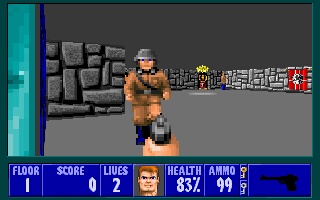
Computer Gaming is something that has been in existence from the very early days of computers. One of the earliest games ever was Pong in 1972. In the 70s and 80s, arcade games, which were played on specialized platforms, became very popular. In the 80s many of these games were rewritten to work on PCs. By the late 80s, multimedia support started the craze of PC gaming.
In 1992, the first famous 3D game, Wolfenstein 3D was released by id Software (the name is written in lowercase). Instead of controlling a two-dimensional character in a two-dimensional environment, the player found himself in a realistic world where he could actually see from the character's point of view. Although Wolf 3D's graphics look cartoonish by today's standards, it is a truly classic game.
1993 marked the actual start of the genre of 3D games, with id Software releasing Doom, which is today considered one of the best and most revolutionary PC games of all time. This was an extraordinarily realistic game and still stands out today. The technological advancements that id had made in such a short time was amazing.
Doom and Doom II (1994), were followed by Duke Nukem 3D (1995, 3D Realms Inc.), and the landmark id Software releases, Quake (1996) and Quake II (1997), which were promptly voted Game of the Year by almost every leading game magazine and website. The next year saw the release of Valve Software's Half-Life, which had a strong science-fiction storyline and many innovations that set it apart from other 3D games. Many other first-person and third-person games have been made, with the most recent ones being Quake III Arena and it's add-on, Team Arena.
The innovations that these games have brought about are more than just something intended for entertainment. The technologies used in these games are something that exploit the latest developments in computer graphics, networking, and artificial intelligence.

This is a picture from the 1984 game Alley Cat by Bill Williams. 4-colour CGA is used.

Whereas in Wolfenstein 3D (1992, id Software) we have a 3D view of the player's environment.

In Doom, the graphics are far more realistic.

The final picture, from Quake III, shows it's truly outstanding graphics capabilities.
[Home]